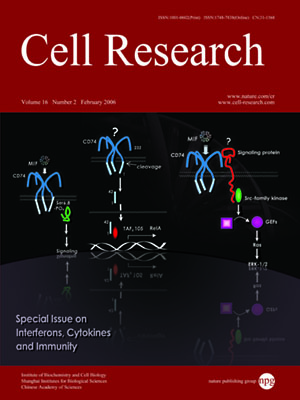
Volume 16, No 2, Feb 2006
ISSN: 1001-0602
EISSN: 1748-7838 2018
impact factor 17.848*
(Clarivate Analytics, 2019)
Volume 16 Issue 2, February 2006: 148-153
REVIEWS
Interferon-γ mRNA attenuates its own translation by activating PKR: A molecular basis for the therapeutic effect of interferon-β in multiple sclerosis
Raymond Kaempfer
Department of Molecular Virology, The Hebrew University-Hadassah Medical School, 91120 Jerusalem, Israel
Correspondence: Raymond Kaempfer(kaempfer@hebrew.edu.)
PKR, the interferon (IFN)-inducible protein kinase activated by double-stranded RNA, inhibits translation by phosphorylating the initiation factor eIF2a chain. Uniquely, human IFN-γ mRNA uses local activation of PKR in the cell to control its own translation yield. IFN-γ mRNA activates PKR through a structure in its 5’- region harboring a pseudoknot which is critical for PKR activation. Mutations that impair pseudoknot stability reduce the ability of IFN-γ mRNA to activate PKR and strongly increase its translation efficiency. The
cis-acting RNA element in IFN-γ mRNA functions as a biological sensor of intracellular PKR levels. During an immune response, as IFN-γ and other inflammatory cytokines build up in the cell’s microenvironment, they act to induce higher levels of PKR in the cell, resulting in a more extensive activation of PKR by IFN-γ mRNA. With the resulting phosphorylation of eIF2a, a negative feedback loop is created and the production of IFN-γ is progressively attenuated. We propose that the therapeutic effect of IFN-β in multiple sclerosis may rest, at least in part, on its exquisite ability to induce high levels of PKR in the cell and thereby to limit IFN-γ mRNA translation through this negative feedback loop, blocking the excessive IFN-γ gene expression that precedes clinical attacks.
Cell Research (2006) 16:148-153. doi:10.1038/sj.cr.7310020; published online 13 February 2006
FULL TEXT | PDF
Browse 2017


